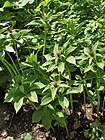Note: This is a project under development. The articles on this wiki are just being initiated and broadly incomplete. You can Help creating new pages.
Difference between revisions of "Paris polyphylla"
(→Uses) |
|||
| Line 2: | Line 2: | ||
'''Paris polyphylla''' is an Asian species of flowering plant native to China, Taiwan, the Indian Subcontinent, and Indochina. It produces spider-like flowers that throw out long, thread-like, yellowish green petals throughout most of the warm summer months and into the autumn. In the fall, the flowers are followed by small, scarlet berries. It is a perennial, which slowly spreads, is fully hardy in Britain, and survives in leafy, moist soil in either complete or partial shade. | '''Paris polyphylla''' is an Asian species of flowering plant native to China, Taiwan, the Indian Subcontinent, and Indochina. It produces spider-like flowers that throw out long, thread-like, yellowish green petals throughout most of the warm summer months and into the autumn. In the fall, the flowers are followed by small, scarlet berries. It is a perennial, which slowly spreads, is fully hardy in Britain, and survives in leafy, moist soil in either complete or partial shade. | ||
==Uses== | ==Uses== | ||
| − | {{Uses| | + | {{Uses|Analgesic}}, {{Uses|Antibacterial}}, {{Uses|Anti- phlogistic}} {{Uses|Antispasmodic}}, {{Uses|Antitussive}}, {{Uses|Any poisonous bites}} {{Uses|Burn}}, {{Uses|Cut or injury}}, {{Uses|Depurative}} {{Uses|Detoxification}}, {{Uses|Diarrhea}}, {{Uses|Dressing}}. |
==Parts Used== | ==Parts Used== | ||
Revision as of 17:02, 11 June 2020
Paris polyphylla is an Asian species of flowering plant native to China, Taiwan, the Indian Subcontinent, and Indochina. It produces spider-like flowers that throw out long, thread-like, yellowish green petals throughout most of the warm summer months and into the autumn. In the fall, the flowers are followed by small, scarlet berries. It is a perennial, which slowly spreads, is fully hardy in Britain, and survives in leafy, moist soil in either complete or partial shade.
Contents
- 1 Uses
- 2 Parts Used
- 3 Chemical Composition
- 4 Common names
- 5 Properties
- 6 Habit
- 7 Identification
- 8 List of Ayurvedic medicine in which the herb is used
- 9 Where to get the saplings
- 10 Mode of Propagation
- 11 How to plant/cultivate
- 12 Commonly seen growing in areas
- 13 Photo Gallery
- 14 References
- 15 External Links
Uses
Analgesic, Antibacterial, Anti- phlogistic Antispasmodic, Antitussive, Any poisonous bites Burn, Cut or injury, Depurative Detoxification, Diarrhea, Dressing.
Parts Used
Chemical Composition
The compounds were identified as: β-sitosterol; ergosta-7, 22-dien-3-one; β-ecdysone; kaempferol; daucosterol; luteolin; calonysterone; luteolin-7-O-glucoside; quercetin; and 3β, 5α, 9α- trihydroxyergosta-7, 22dien-6-one. Compounds 2, 6 and 10 were isolated from Paris polyphylla var. [1]
Common names
| Language | Common name |
|---|---|
| Kannada | |
| Hindi | |
| Malayalam | |
| Tamil | |
| Telugu | |
| Marathi | NA |
| Gujarathi | NA |
| Punjabi | NA |
| Kashmiri | NA |
| Sanskrit | |
| English | Himalayan Paris |
Properties
Reference: Dravya - Substance, Rasa - Taste, Guna - Qualities, Veerya - Potency, Vipaka - Post-digesion effect, Karma - Pharmacological activity, Prabhava - Therepeutics.
Dravya
Rasa
Guna
Veerya
Vipaka
Karma
Prabhava
Habit
Identification
Leaf
| Kind | Shape | Feature |
|---|---|---|
| Simple | rounded to cuneate in shape | Leaves are found in a whorl of 4 to 9 leaves and they are petioled (4–6 cm), Leaves are 2.5–5.0 cm wide. The dull-green leaves contain three primary veins and spread out in a horizontal whorl at the top of the stem |
Flower
| Type | Size | Color and composition | Stamen | More information |
|---|---|---|---|---|
| Bisexual | narrowly ovate-lanceolate to lanceolate | yellow-green | 3–5 mm in length, while the inner tepals are usually yellow-green, narrowly linear, and are shorter or longer than outer ones (about 1.5 mm long). |
Other features
List of Ayurvedic medicine in which the herb is used
Where to get the saplings
Mode of Propagation
How to plant/cultivate
Paris polyphylla Sm. (Satuwa) is one of the medicinal plants listed as vulnerable by the IUCN. Seed viability was found to be low and the seeds did not germinate in laboratory conditions even under different chemical treatments. There seems to be a need for raising awareness amongst people who live in environments in which Paris polyphylla propagates. [3]
Commonly seen growing in areas
Photo Gallery
References
External Links
- Ayurvedic Herbs known to be helpful to treat Analgesic
- Ayurvedic Herbs known to be helpful to treat Antibacterial
- Ayurvedic Herbs known to be helpful to treat Anti- phlogistic
- Ayurvedic Herbs known to be helpful to treat Antispasmodic
- Ayurvedic Herbs known to be helpful to treat Antitussive
- Ayurvedic Herbs known to be helpful to treat Any poisonous bites
- Ayurvedic Herbs known to be helpful to treat Burn
- Ayurvedic Herbs known to be helpful to treat Cut or injury
- Ayurvedic Herbs known to be helpful to treat Depurative
- Ayurvedic Herbs known to be helpful to treat Detoxification
- Ayurvedic Herbs known to be helpful to treat Diarrhea
- Ayurvedic Herbs known to be helpful to treat Dressing
- Herbs with Leaves used in medicine
- Herbs with common name in English
- Habit - Herbs
- Index of Plants which can be propagated by Seeds
- Herbs that are commonly seen in the region of Lowland forest
- Herbs
- Melanthiaceae



